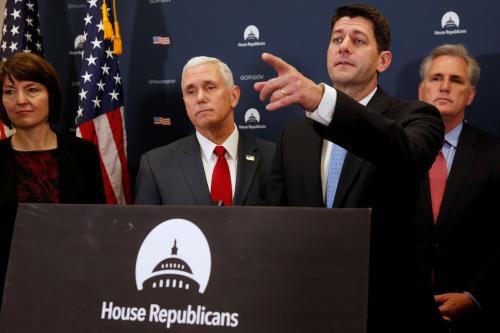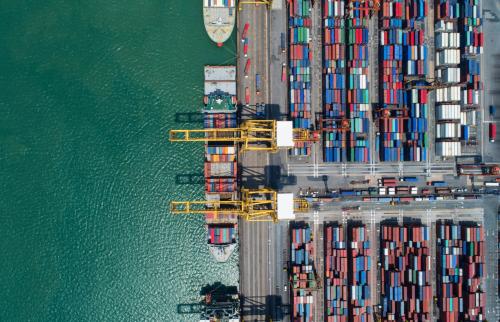This article was originally published on Real Clear Markets on February 7, 2017.
The House Republican tax plan proposes to transform the corporate income tax into a destination-based cash flow tax (DBCFT), which would include border adjustments that exempt exports but include imports in tax bills. The effects of the border adjustment on the economy depend on how exchange rates respond. However, the potential response is a source of significant confusion and uncertainty. Here’s what we do and don’t know.
First, some background: The DBCFT is a modified version of a value added tax (VAT); it allows deduction for wages, while VATs do not. The VAT is a consumption tax, so it exempts the normal return from investment from tax. Thus, the DBCFT only taxes consumption financed by certain types of capital income – namely, returns to previous investments and supra normal returns to new investments.
A border adjustment makes sense for a domestic consumption tax like a VAT since exports are not consumed domestically, but imported goods and services are. This makes the border adjustment a policy that levels the playing field so that all goods consumed in the US face the same tax rate regardless of where they are produced. Thus, it is quite different from a selective tariff.
All advanced countries except the US already have VATs (on top of corporate income taxes), and all of those VATs are border-adjusted. The border adjustment for VATs is explicit – taxes on production are rebated for exports; imports are taxed.
All advanced countries except the US already have [a value added tax] (on top of corporate income taxes), and all of those VATs are border-adjusted.
While explicit border adjustments may seem like a strange concept to Americans, implicit border adjustments are already present in state-level retail sales taxes. Goods produced in state A and exported to and sold in state B do not face state A’s sales tax. Goods produced in state B and imported to state A do face state A’s sales tax.
The border adjustment for a cash flow tax would also be implicit – the tax would exclude exports from tax and would not allow deductions for the cost of imported goods. By ignoring foreign transactions, the cash flow tax with border adjustment also removes the incentive for firms to relocate profits or move profitable activities outside of the country.
However, the border adjustment in the House Republican plan is probably not WTO-compatible. The WTO requires that imports and domestically produced goods be treated the same. But the DBCFT taxes the whole value of imports while only taxing the part of domestically produced goods that relates to above-normal returns to capital owners. This could be addressed by separating the DBCFT into a regular value-added tax and a wage subsidy elsewhere in the system.
WTO issues aside, simple economic theory implies that the exchange rate should rise immediately (the dollar should go up in value) by the full extent of the tax. There are two ways to see this. First, the exemption of exports would raise demand for US dollars as foreigners need more dollars to purchase more exported US goods. Similarly, the tax on imports would restrict the supply of dollars worldwide as Americans made fewer purchases from abroad. The two effects would serve to raise the value of the dollar and have offsetting effects on the quantity of dollars traded.
A second way to see this point is to note the national income accounting identity in which the difference between domestic saving and domestic investment must equal the difference between exports and imports. If the border adjustment does not affect saving and investment (more on that below), it cannot change the difference between exports and imports. If the quantities do not change, the price (the value of the dollar) must adjust to keep the equilibrium. (Other features of the reform package could change saving and investment.)
If the theory is correct and the exchange rate fully adjusts – i.e., rises by the level of the tax – the border adjustment would have no effect on the trade balance, the level of exports, the level of imports, the domestic price level, or the net profitability of importers and exporters. (Again, other parts of the reform proposal could affect these items, though.) The rise in the dollar’s value would create a substantial transfer of wealth from Americans holding assets overseas (for example, in their retirement accounts) to foreigners holding assets in the United States. It could also mean trouble for emerging-market debtor countries that hold debt in dollar-denominated terms, but hold their assets in their own currencies. This is similar to what happened in the Asian financial crisis in the late 1990s.
There are numerous skeptics, however, both inside and outside the economics profession on whether exchange rates would adjust fully. They highlight two concerns with the “simple economic theory” – the “simple” and the “theory” parts.
The first simple example given above assumes that the border adjustment would not affect capital market flows. But it probably would, at the very least, because international investors would want to rebalance their portfolios, once their dollar-denominated investments rose by 25 percent. The second example assumes that the border adjustment would not affect saving and investment. But it probably would since it would raise revenue for the government (because imports are greater than exports) over the next 10 years and so would affect government saving.
In addition, a number of factors make it difficult to estimate the exchange rate effects of border adjustment. Exchange rates can be excessively volatile, especially if the prices of goods and services adjust slowly to new events. The amount of foreign exchange related to trade flows is dwarfed by the amount related to asset purchases and sales. Some governments aim to control their exchange rates. (Although any country that does not let the dollar rise will just be making itself less competitive.) Pre-existing contracts may muddy exchange rate dynamics. Investors may hedge their bets until WTO resolution occurs. Plus, the fact that U.S. exports and imports are almost exclusively invoiced in dollar terms tends to dampen price responses to exchange rates. In any case, achieving complete exchange rate adjustment is dependent on all business tax rates being equal. If there are different rates for corporations (20 percent) and pass-through entities (25 percent), as under the House plan, then it is impossible to have a single “full” offsetting exchange rate change.
If the exchange rate does not adjust fully and immediately, though, the effects of the border adjustment could be quite different. Exports would rise, imports would fall, and the trade deficit would fall. Consumer prices would rise, fueled by higher import costs, and this would hit low-income households disproportionately. Exporters would enjoy larger profits, while importers – most notably, in apparel, oil, and retailing – would be hurt. The short-term revenue yield of the tax would decline (since the tax on imports would bring in less and the subsidy for exports would be more expensive). There would be less wealth transfer from Americans to foreigners, and less new debt troubles for emerging-market countries.
What would actually happen to exchange rates? Convincing empirical evidence is difficult to come by. The analysis is tricky, because financial markets can anticipate legislative changes, so that much or most of any adjustment may well have occurred before a border adjustment takes effect. There is suggestive evidence of full exchange rate offset for border-adjustable taxes but it comes from data from smaller countries who initiated smaller border-adjustable taxes than the U.S. is considering.
My sense – rather than my firm conviction – given the theory and evidence to date, is that it is likely that border adjustment will create rapid and significant – maybe even close to full – exchange rate adjustments. But there is still a nontrivial risk that it would not, and that is what is keeping opponents awake at night.
The Brookings Institution is committed to quality, independence, and impact.
We are supported by a diverse array of funders. In line with our values and policies, each Brookings publication represents the sole views of its author(s).










Commentary
Op-edA quick guide to the ‘border adjustments’ tax
February 7, 2017